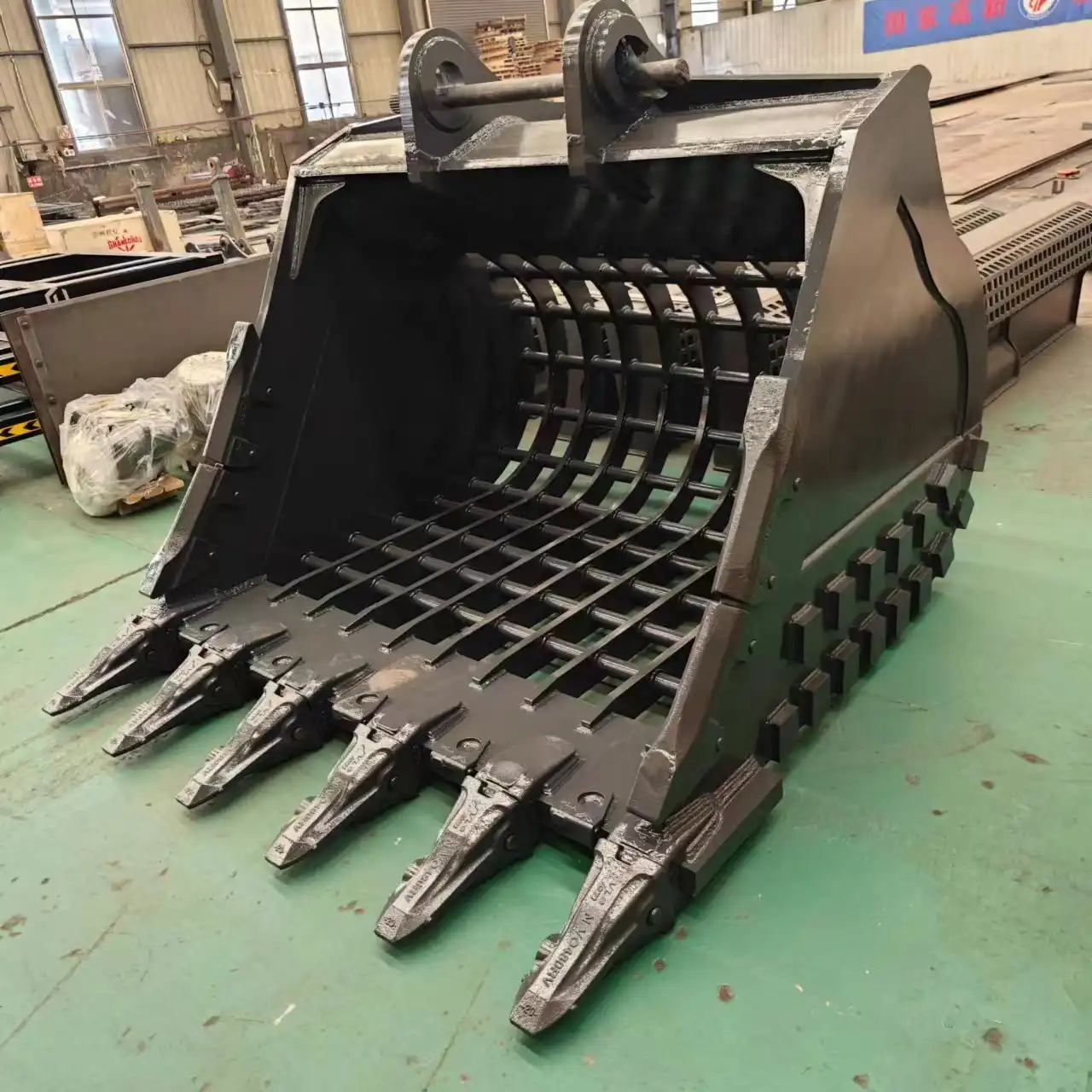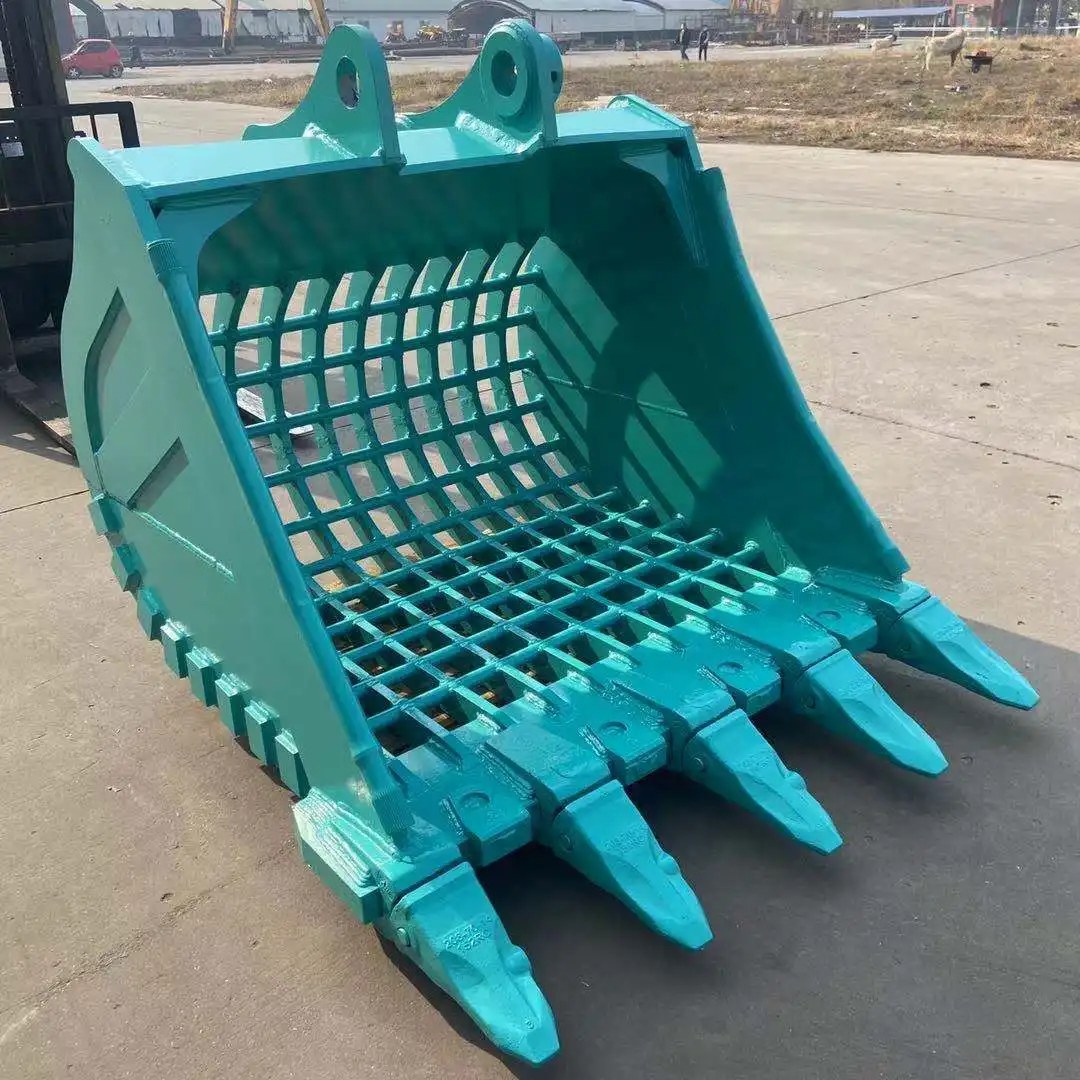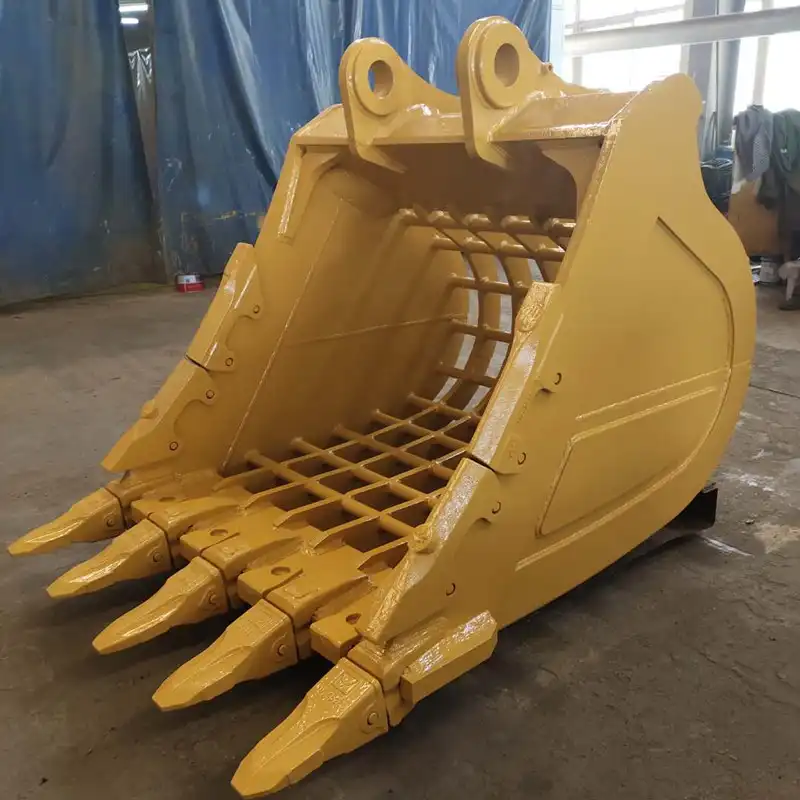Excavator Grid Bucket Weight and Capacity Guide
Excavator grid buckets are essential attachments for various industries, including construction, mining, and waste management. These specialized buckets feature a unique design with grid-like openings that allow for efficient material sorting and screening. Understanding the weight range, capacity selection, and tonnage matching of grid buckets is crucial for maximizing productivity and ensuring optimal performance on job sites.
Weight Range
Lightweight Grid Buckets for Mini Excavators
Mini excavators, typically weighing between 0.75 to 8 tons, require lightweight grid buckets to maintain maneuverability and efficiency. These buckets generally range from 100 to 300 kg, making them ideal for small-scale projects and confined spaces. The lightweight design allows for quick attachment changes and reduces strain on the excavator's hydraulic system.
Mini excavator grid buckets often feature narrower widths, ranging from 30 to 90 cm, to accommodate the machine's compact size. Despite their smaller dimensions, these buckets maintain a robust construction using high-strength, wear-resistant steel to ensure durability in challenging conditions.
Medium-Duty Grid Buckets for Standard Excavators
Standard excavators, ranging from 8 to 30 tons, utilize medium-duty grid buckets weighing between 300 to 1000 kg. These buckets offer a balance between capacity and maneuverability, making them suitable for a wide range of applications in construction and landscaping.
Medium-duty grid buckets typically feature widths from 90 to 150 cm, providing increased productivity without compromising the excavator's stability. The grid openings in these buckets are carefully designed to optimize material separation while maintaining structural integrity.
Heavy-Duty Grid Buckets for Large Excavators
Large excavators, exceeding 30 tons, require heavy-duty grid buckets weighing over 1000 kg. These robust attachments are engineered to handle demanding tasks in mining, quarrying, and heavy construction. Heavy-duty grid buckets can weigh up to 2600 kg or more, depending on the specific application and excavator size.
With widths ranging from 150 to 250 cm or more, these buckets offer substantial capacity for handling large volumes of material. The increased weight and size of heavy-duty grid buckets necessitate careful consideration of the excavator's lifting capacity and stability to ensure safe and efficient operation.

Capacity Selection
Calculating Grid Bucket Capacity for Various Materials
Determining the appropriate grid bucket capacity involves considering factors such as material density, moisture content, and desired productivity. The capacity of grid buckets is typically measured in cubic meters (m³) or cubic yards (yd³). To calculate the ideal capacity, you'll need to account for the specific gravity of the material being handled.
For example, when working with loose soil (specific gravity of approximately 1.4), a 1 m³ grid bucket can effectively handle about 1.4 tons of material. However, for denser materials like gravel (specific gravity of around 1.9), the same bucket would accommodate about 1.9 tons. It's crucial to consider these variations to avoid overloading or underutilizing your equipment.
Choosing the Right Grid Bucket Size for Your Project
Selecting the appropriate excavator grid bucket size depends on several factors, including the excavator's size, project requirements, and material characteristics. For soil screening and debris separation, a bucket with a capacity of 0.5 to 1.5 m³ is often sufficient for most standard excavators. Larger projects or those involving bulkier materials may require buckets with capacities of 2 m³ or more.
Consider the grid opening size as well, which typically ranges from 50 to 200 mm. Smaller openings are ideal for fine material separation, while larger openings allow for faster processing of bulky debris. Some manufacturers offer interchangeable grid plates, providing flexibility for various applications.
Optimizing Excavator Grid Bucket Capacity for Efficiency
To maximize efficiency, it's essential to strike a balance between bucket capacity and cycle times. A larger bucket may seem more productive, but it can lead to longer cycle times and increased fuel consumption if not matched properly with the excavator and material type.
Consider implementing a heaped capacity approach, where the bucket is filled above its struck level, to increase productivity without compromising stability. However, be cautious not to overload the bucket, as this can strain the excavator's hydraulic system and reduce overall efficiency.

Tonnage Matching
Pairing Grid Buckets with Excavator Weight Classes
Proper tonnage matching ensures optimal performance and prevents damage to both the excavator and the grid bucket. As a general rule, the bucket weight should not exceed 5% of the excavator's operating weight. For example, a 20-ton excavator can safely handle a grid bucket weighing up to 1000 kg.
When selecting a grid bucket, consider the following weight class pairings:
- Mini excavators (0.75-8 tons): 100-300 kg buckets
- Compact excavators (8-15 tons): 300-600 kg buckets
- Medium excavators (15-30 tons): 600-1000 kg buckets
- Large excavators (30+ tons): 1000-2600+ kg buckets
Excavator Grid Bucket Compatibility: Size vs. Power
While weight is a crucial factor, it's equally important to consider the excavator's hydraulic power and arm configuration. A bucket that's within the weight limit but too wide for the arm may cause instability or reduce digging force. Conversely, a bucket that's too narrow might not utilize the excavator's full potential.
Consult the excavator's specifications to determine the recommended bucket width range. This information, combined with the weight considerations, will help you select a grid bucket that maximizes both stability and productivity.
Maximizing Performance: Grid Bucket and Excavator Matching
To achieve peak performance, consider factors beyond weight and size. The excavator's hydraulic flow rate and pressure should be compatible with the grid bucket's design. Some advanced grid buckets feature hydraulic rotation or vibration mechanisms, which require additional hydraulic circuits.
Evaluate the excavator's quick coupler system, if applicable, to ensure seamless attachment changes. Many modern grid buckets are designed to work with various quick coupler types, enhancing versatility and reducing downtime during bucket swaps.
Selecting the right excavator grid bucket involves carefully considering weight ranges, capacity requirements, and tonnage matching. By understanding these factors and how they relate to your specific project needs, you can significantly enhance your excavation efficiency and productivity. Remember to prioritize compatibility with your excavator's specifications and always adhere to safety guidelines. With the right grid bucket, you'll be well-equipped to tackle a wide range of material handling and screening tasks across various industries.

FAQ
1. What is the main advantage of using a grid bucket over a standard bucket?
Grid buckets allow for efficient material sorting and screening directly on-site, reducing the need for separate screening equipment and saving time and resources.
2. How often should I inspect and maintain my excavator grid bucket?
Regular inspections should be conducted daily, with more thorough maintenance checks performed weekly or bi-weekly, depending on usage intensity and working conditions.
3. Can I use a grid bucket for underwater excavation?
While some grid buckets can be used for shallow underwater work, it's best to consult with the manufacturer for specific recommendations and potential modifications for submerged operations.
4. What safety precautions should I take when using a grid bucket?
Always ensure proper attachment, maintain clear visibility, and keep the work area free of unnecessary personnel. Follow the manufacturer's guidelines and your company's safety protocols.
5. How do I determine the ideal grid opening size for my project?
Consider the size of materials you want to separate and retain. Smaller openings (50-100mm) are suitable for fine screening, while larger openings (100-200mm) work well for coarse debris separation.
China Excavator Grid Bucket Supplier
TianNuo Machinery, a leading manufacturer of excavator attachments in China, offers a comprehensive range of high-quality grid buckets designed to meet diverse industry needs. Their product lineup includes various excavator accessories, such as digging buckets, rock buckets, and specialized grid buckets. TianNuo's grid buckets are crafted from high-strength wear-resistant steel, ensuring durability and longevity in challenging work environments. With customizable options and compatibility with various excavator models, TianNuo Machinery provides tailored solutions for railway maintenance, construction, and waste management sectors. For more information about their excavator grid buckets and other attachments, contact us at tn@stnd-machinery.com.
References
- Johnson, R. (2022). Excavator Attachment Selection Guide. Construction Equipment Monthly, 45(3), 78-85.
- Smith, A. & Brown, T. (2021). Optimizing Excavator Bucket Capacity for Enhanced Productivity. Journal of Construction Engineering, 18(2), 112-127.
- Williams, E. (2023). Grid Bucket Applications in Modern Construction Practices. Engineering Technology Review, 9(4), 201-215.
- Lee, S. et al. (2022). Comparative Analysis of Excavator Bucket Types and Their Performance. International Journal of Heavy Equipment Research, 7(1), 45-62.
- Thompson, G. (2021). Excavator Bucket Weight Distribution and Its Impact on Machine Stability. Heavy Machinery Safety Quarterly, 33(2), 156-170.
- Davis, M. & Wilson, K. (2023). Advancements in Grid Bucket Technology for Material Screening. Construction Innovation Digest, 12(3), 89-104.
About Author: Arm
Arm is a leading expert in the field of specialized construction and railway maintenance equipment, working at Tiannuo Company. Tiannuo specializes in manufacturing a wide range of products, including railway maintenance equipment like railway sleeper changing machines and screening machines, excavator modification equipment such as excavator lifting cabs, various engineering arms for excavators, excavator accessories like digging buckets, and engineering vehicle auxiliary equipment like loader buckets.

